- ALL ARTICLES
- How To Study Effectively
- Motivation & Stress
- Smarter Study Habits
- Memorise Faster
- Ace The Exam
- Write Better Essays
- Easiest AP Classes Ranked
- Outsmart Your Exams
- Outsmart Your Studies
- Recommended Reads
- For Your Students: Revision Workshops
- For Your Teaching Staff: Memory Science CPD
- Our Research: The Revision Census
- All Courses & Resources
- For School Students and Their Parents
- For University Students
- For Professionals Taking Exams
- Study Smarter Network
- Testimonials


70+ Connective Words To Power Up Your Essays [COMPREHENSIVE LIST]
by Kerri-Anne Edinburgh | Last updated Jul 23, 2024 | First published on Aug 5, 2021 | 1 comment
When you’re writing an essay or assignment, you need to use every trick in the book to maximise your marks. And one of the best tools for radically improving your writing is the power of connective words .
Used correctly, connective words can give your writing new depth and meaning, improve readability (important for your examiner!) and demonstrate the logic of your arguments.
Luckily for you, we’ve got plenty of categories, definitions and connectives examples to help you get started…
Psst – this article uses loads of connectives. See if you can spot them in use: we’ve italicised the best examples!
What are connective words?
Simply put, connectives are words – or phrases – that link parts of your writing together.
You’re probably familiar with the most common connective words: and, as, because, but, if, or, so . In fact, I’ve used a few of them already – did you spot them?
Don’t limit your essay writing to the basics though, because there are hundreds of connectives that can help you to demonstrate different ideas, such as cause and effect , or the chronology of events .
We’re going to explore ten types of connectives below, but first , here’s a quick refresher on the grammar behind connective words:
Definitions: The grammatical bit
Understanding the grammar behind your writing might not be your thing – but bear with me, because remembering these six definitions will help you know which connective to use when, and where to place them!
(If you’re just looking for examples of connectives, feel free to skip straight past this bit!)
Connectives fall into three grammatical categories: conjunctions, prepositions, and adverbs.
- For example: and, but, for, or, yet .
- Today , I finished my history assignment but forgot to workout .
- Such as: at, in, of, on, under .
- I need to finish the conclusion of my essay before I go to dinner.
- For instance: upwards, quickly, fortunately .
- My deadline is tomorrow. Fortunately , I proofread my thesis chapter already .
Using adverb and preposition connective words adds specific meaning – and thus clarity – to your writing. They are particularly useful for successful essay signposting .

Definitions part 2: Connectives in sentences
When using connectives, it’s also important to remember that not all sentences are created equal in importance . And so , when connecting them into longer sentences, different types of connectives create different results:
- For example: I find French tricky but I love learning Spanish.
On the other hand,
- A subordinate clause relies on the main clause to make sense. Therefore, these connectives give information about the relationship between the clauses by specifying an order or place to events, or a cause and effect link.
- Here’s an example: I need to do my homework if I want to get a good grade .
A useful type of subordinating connective for essay writing is the:
- For instance: Firstly , I carried out the experiment, and secondly , I analysed the results.
And that’s your grammar refresh done!
If you’re struggling with essay-writing grammar, a great tool for checking your writing is Grammarly – we use it at Exam Study Expert because it catches a broad range of mistakes.
The where, what and how of using connectives
So how do you go about using connectives?
In this section, we’re going to discuss the where, what and how …
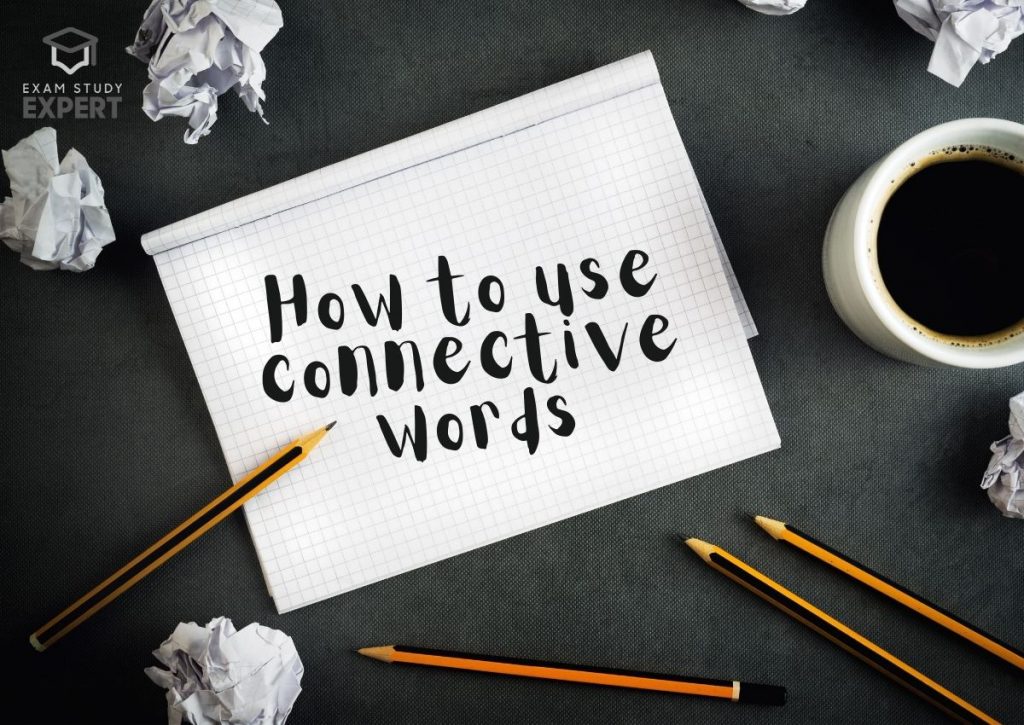
Where to add connectives:
As we’ve seen , connective words are often found in the middle of a sentence, joining two clauses. But don’t forget you can also use them at the beginning of a sentence to link two consecutive sentences – OR two ideas within your paragraphs (did you see what I did there?).
Some of your connectives will even be linking entire paragraphs and sections – these are often examples of signposting to guide the reader through your section or argument.
What’s more , many connectives are not just single words but phrases. These connectives are particularly useful for essay writing and academic vocabulary. For example: as well as, for an example of this, for instance, in addition to, on the other hand, such as .
What to use connectives for:
When you’re writing an essay or assignment there are plenty of tasks you need to achieve: presenting evidence, making arguments and more.
Happily, connectives can help you achieve all these tasks by clarifying your meaning. You can use connectives for:
- Reinforcing or emphasising a point
- Exemplifying and showing results
- Comparing and discussing points of view
- Constructing a timeline or sequence of events
- Listing points (and signposting them)
- Explaining your argument
- Drawing together conclusions
It’s a long list! So master using connectives and you’ll drastically improve the readability of your writing across all sections of your essay.
How to add in useful connective words:
You’re probably already using basic connectives in your writing.
But if you want to get serious about the benefits to your grades, make sure you’re systematic about how you add them during your essay construction – and (later) proofreading to check they make sense on a large(r) scale!
From experience, I would suggest that the best method for choosing and adding effective connectives is to:
- Sketch out a rough draft of your paragraph or essay section
- Are they separate arguments for the same thing? Or opposite points of view? Do they follow on logically (cause and effect) or chronologically?
- Mark where you want to add signposting connectives to indicate structure
- Check your examples of connective word types and choose options that convey the meaning you need…
And for that purpose, we’ve compiled four lists of connective words for you – including the TOP 70 connectives for effective essay writing! So read on…
The three types of connective words:
So let’s get down to the really useful stuff: examples of connectives you can use in different situations in your essays!
There are three main types of connectives that we’re going to explore in turn:
- Comparative , Causal, and Temporal
Comparative connective words
These helpful words and phrases are perfect both for comparing similarities in data and arguments, and for pointing out their differences and oppositions. Use them to compare, discuss and argue.
When comparing points, you’ll often be adding to your argument, so these connectives are used for “ addition ”. The most common connectives for addition are: and, also, furthermore, moreover .
Here are some examples in practice:
- Leonardo Da Vinci was an artist and inventor, and also an influential Renaissance humanist.
- Exam Study Expert’s psychologist William offers expert one-on-one exam coaching . Furthermore , you can sign up for a free introductory session!
- My empirical data demonstrates that … ; similarly , theoretical models projected …
On the other hand , you might need to demonstrate and contrast your argument with the opposing point of view with a connective for “ opposition ”. The most commonly used are: alternatively, except, however, unless .
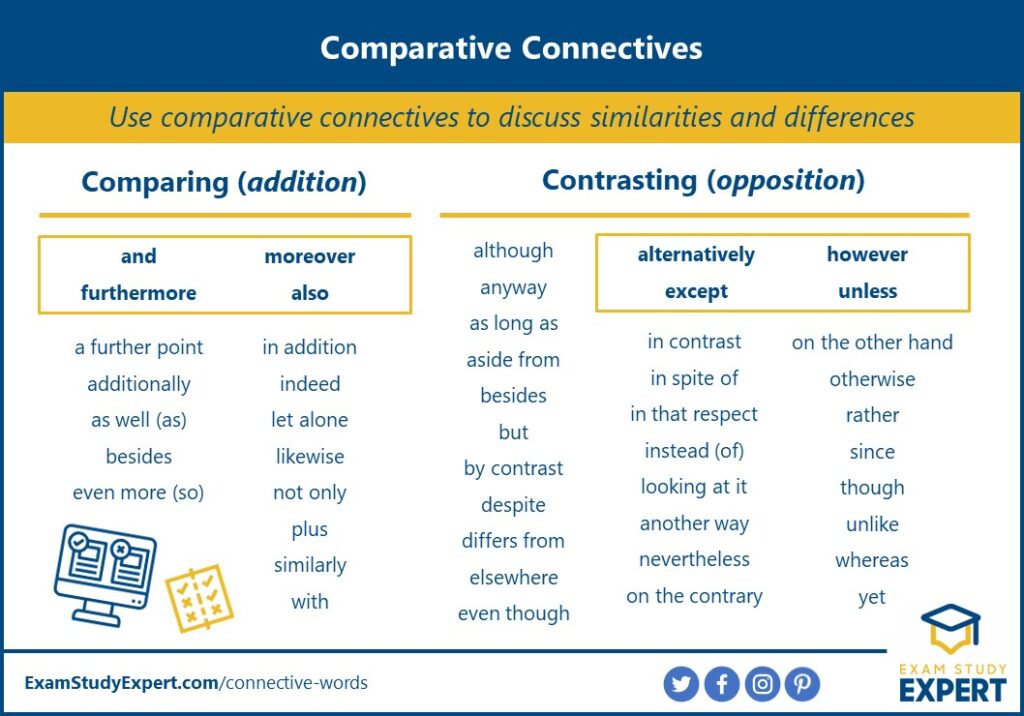
These examples all demonstrate opposition:
- Winston Churchill is best known for his wartime leadership of the United Kingdom, yet he was already in his 60’s when he took office.
- Some students find great study motivation from starting the day with their hardest task. In contrast , others find getting the ball rolling with smaller tasks more effective.
- Our first questionnaire was comprised of six questions. However , for our second questionnaire we …
Causal connective words
Causal connectives are effective for discussing cause and effect – relationships that have logical links that you want to point out and prove.
As such , academic writing is often full of causal connectives, and many of them demonstrate a very academic vocabulary (great for bonus points in your assignment!).
Most essays and assignments have a section (or several sections!) where you need to draw together your facts, ideas and arguments and point out the connections. These are the connectives to turn to at those moments!
The most commonly used are: as such, as a result (of), because, consequently, therefore, thus .
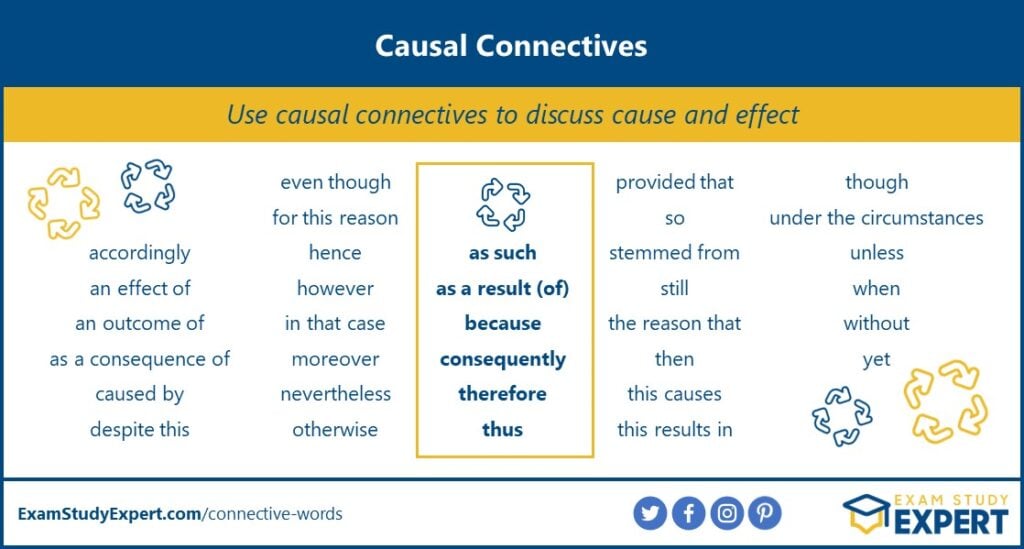
Here are some examples:
- The brains of London taxi drivers have a larger than usual area that deals with memory because they are required to memorise and navigate thousands of streets.
- Flashcards are a highly effective learning and memory tool, provided that you use them correctly.
- This study surveyed over 3,000 students. As a result , we were able to …
Temporal connective words
Whether you’re explaining the sequence of events that led to a historical battle, or demonstrating the steps in your experiment, temporal connectives are a highly valuable tool.
They’re all about discussing time and the chronology of events – what happened before, during and after . Therefore , they make for great signposting words too!
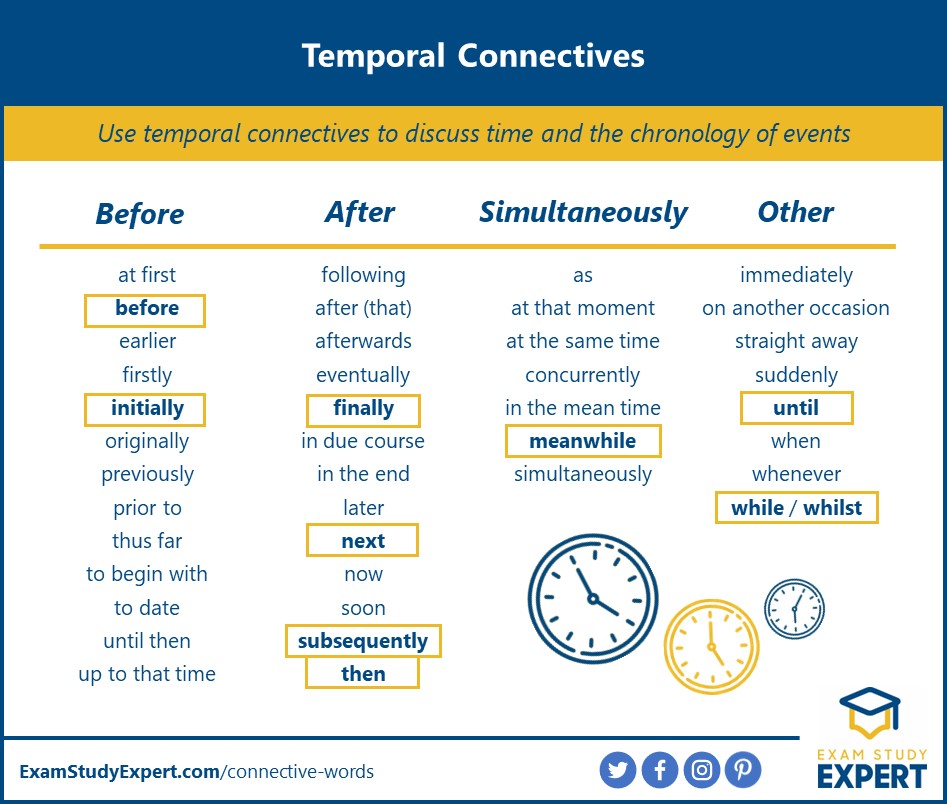
These examples explore each of the four sections in our temporal connectives lists:
- The law of gravity was not widely understood until it was mathematically formulated by Sir Isaac Newton in 1687.
- If you’re stressed about your exams, mindful meditation can be a great help. At the same time ,an inspirational quote might give you the boost you need!
- Initially , the experiment was expected to demonstrate … Eventually , we came to the conclusion that …
The TOP 70 connective words for effective essay writing!
To make sure that you’ve got the tools you need to improve your grades, we’ve compiled this epic list of all the best connectives to use in academic writing.
This is just a selection from the hundreds of connective words and phrases available. So there’s no need to make your essay stale by over-using the same one or two!
If there’s nothing else you grab when you’re ticking off Step #4 from the connectives methodology above – make sure you grab this list!
It covers all the stages of essay structuring and writing, from introduction to conclusion . And includes lists of connectives for:
- Signposting and listing
- Comparing and contrasting
- Illustrating your findings
- Demonstrating cause and effect
- Emphasising points
- Qualifying your arguments
We’ve highlighted the best and most commonly used connectives for each section to ensure you’ve got THE best resource to improve the quality of your essay immediately.
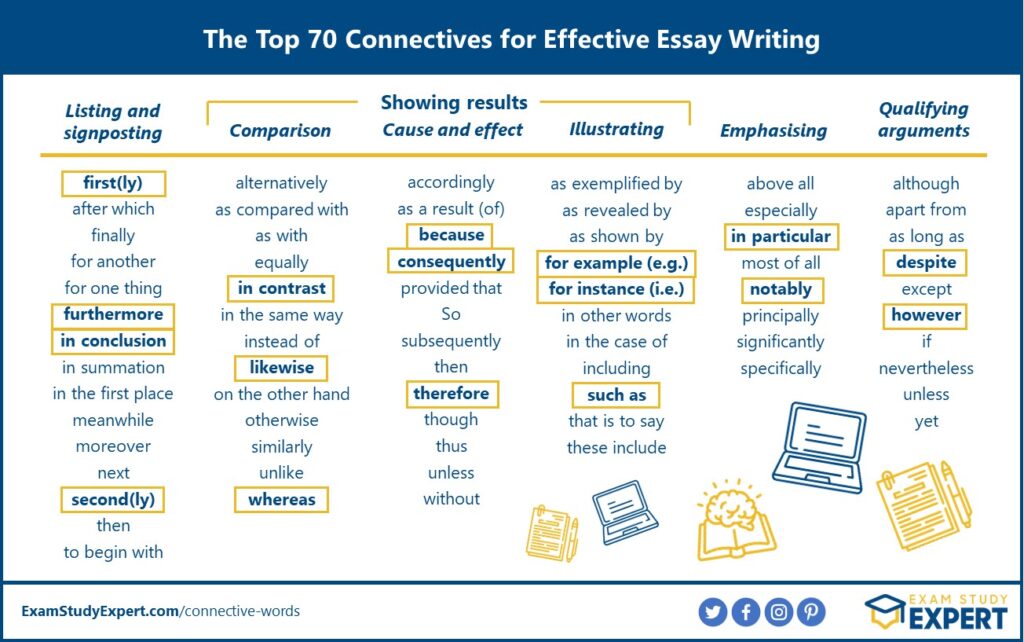
To finish off , here are some examples to get your essay-writing inspiration flowing:
- Firstly , it is well-known that retrieval practice is an effective learning method as compared with re-reading study texts and notes.
- I’m feeling tired tonight. Nevertheless , I must finish my homework and I want to take the dog for a walk.
- When it comes to …, however , there are several effective methods to …, in particular , …
Good luck with your essay!
Now you’ve mastered adding effective connective words to your essay you’re ready for the next step. Be sure to check out our guide on proofreading your assignment before you hand it in. Good luck!
And for more expert, science-backed study resources, sign up to the Exam Study Expert newsletter right here:
The Science Of Studying Smart
Download my free exam success cheat sheet: all my #1 must-know strategies to supercharge your learning today.
Your privacy protected. No spam. Unsubscribe any time.
such an informative blog for the aspirants who are preparing for any exams
Submit a Comment Cancel reply
Your email address will not be published. Required fields are marked *
This site uses Akismet to reduce spam. Learn how your comment data is processed .
Read My Test-Taking Technique Book For More Marks In Exams

Top Picks: Recommended Reading From The Blog
How To Study Effectively : Ultimate Guide [READER FAVOURITE]
Why Study [READER FAVOURITE]
Exam Memorization Secrets
Inspirational Exam Quotes
Finding The Perfect Study Routine
Pomodoro Method : 9-Step Guide
Best Books About Studying
Listen To The Podcast

- Academic writing
- Commonly confused words
- Critical thinking
- PEEL Paragraphs
- Linking/transition words
- Paraphrasing
- Proofreading
- Terms and definitions
- Action Words: What is description, application, analysis and evaluation
Linking/transition words: Things you need to know...
All assignments are written in formal language. You need to ensure that you demonstrate your knowledge and understanding alongside your ability to answer the question/solve the problem.
Below are some ideas to help you to develop your structure and flow.
- Linking / transition words and phrases join ideas, sentences and paragraphs together. They should be used within sentences and to move from one idea to another (between sentences).
These words and phrases indicate the direction, order and flow of ideas. Significantly, they strengthen the quality and structure of your work.
- Redundant Words - less is more. P articularly when trying to reduce the word count, it is important to look for phrases which can be replaced with a single word.
Linking/Transition Words
Transitions link one main idea to another separated by a semi-colon or full-stop. When the transition word is at the beginning of the sentence, it should be followed by a comma:
Among other functions, they can signal cause and effect or sequencing (see examples in the table below).
Linking words: conjunctions
Linking words within a sentence are referred to as coordinating conjunctions. Do not worry about the term: think about the function.
Conciseness / redundant words
Microsoft Word now has an additional feature within the Edito r - it is called conciseness or wordiness.
- If you cannot see the Editor menu a quick tip is to hold down the function (fn key at the bottom left of the keyboard) + F7 (top line of keys).
- From the Refinements section - select Conciseness - if there are any suggestions a number will appear in the box alongside this option
- A dotted line will appear under any groups of groups
- Either select the identified text by clicking with your right mouse button OR click on the down down next to the Conciseness menu.
- MS Word will display any alternative words which you can either select and they will be replaced in your text or reject if you want to keep the original phrases.
Examples: try to replace phrases with a single words which mean the same.
Need to know more...
- Related pages
- External links
- Academic writing Illustrates the main features of academic writing so that you are aware of what it is and what it involves
- Critical Thinking Academic work involves thinking, not just accepting what you read or are told.
- Terms and Definitions Important words appear in your assignments and examinations. The aim of this factsheet is to help you to fully understand what they mean.
Additional resources to help you to improve your confidence and grades:-
- Writing Effectively demonstrates the importance of: clarity, structure, relevance, argument and precision.
- Writing Mechanics gives further examples and resources on areas including: sentence structure, vocabulary, spelling, punctuation and grammar.
Linking/Transition words - Scribbr https://www.scribbr.co.uk/syntax/transition-words-examples/ [Accessed 10 February 2023]
There are many books concerning academic writing, look around Dewey number 808
- << Previous: PEEL Paragraphs
- Next: Paraphrasing >>
- Last Updated: Aug 29, 2024 9:40 AM
- URL: https://libguides.staffs.ac.uk/academic_writing
- Library and Learning Services, University of Staffordshire, College Road, Stoke-on-Trent, ST4 2DE
- Accessibility
- Library Regulations
- Appointments
- Library Search

200+ Linking Words – Full List, Examples
| Candace Osmond
Candace Osmond
Candace Osmond studied Advanced Writing & Editing Essentials at MHC. She’s been an International and USA TODAY Bestselling Author for over a decade. And she’s worked as an Editor for several mid-sized publications. Candace has a keen eye for content editing and a high degree of expertise in Fiction.

Worried that your essay lacks structure and coherence? Perhaps you should use linking words, transition words, or connectors to give it a boost.
Linking words join separate sentences to improve writing flow. You can also find them mid-sentence to connect clauses.
Read on as I show you the definition and types of linking words in English. I also list examples of linking words under every category, and I whipped up a helpful worksheet to test your skills.
What Are Linking Words?
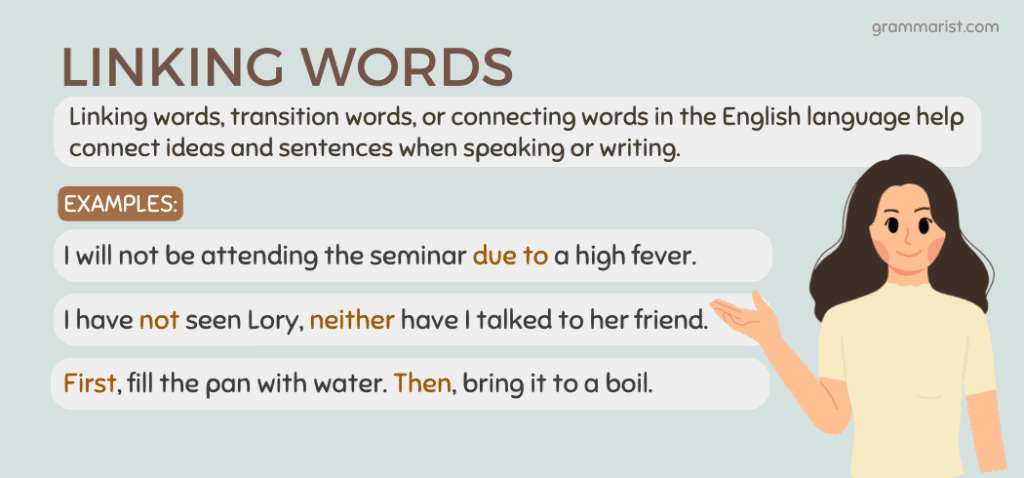
Linking words, transition words, or connecting words in the English language help connect ideas and sentences when speaking or writing.
Linking words and phrases are connectors or transitional phrases. They are also part of formal language, so you’ll find them in academic writing, opinion writing, critical essays, dialectic essays , journalism, and business documents.
Some linking verbs link clauses within a sentence, such as although, in case, and whatever. That means you can find them in the middle of sentences from time to time. Others link two complete sentences, such as besides, as a result, and however.

List of Transition Words
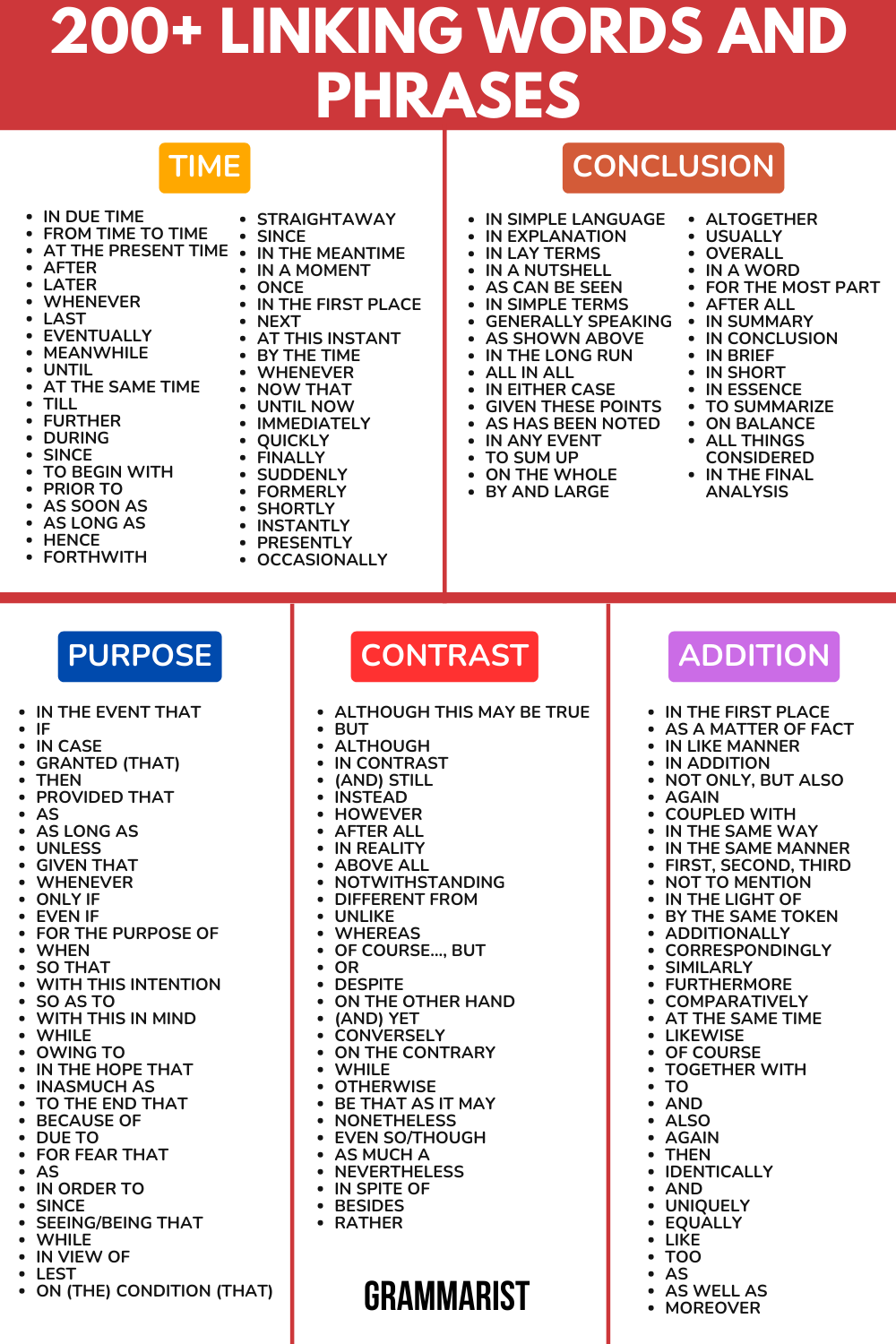
Now that you know the meaning of transition words, let’s look at the usage of transition words in sentences and clauses. Don’t worry, I’ll break it all down for you!
Below, I’ve got a list of linking words and phrases to serve as alternative choices for connecting ideas in writing. Note that there are several types of transition words which we will discuss later.
Agreement/Addition/Similarity
Linking words may help the reader understand additional comments or ideas in a statement. They may also express agreement or similarities. These words are also called additive transition words, commonly found in expository essays and narrative essays.
- In the first place
- As a matter of fact
- In like manner
- In addition
- Not only, but also
- Coupled with
- In the same way
- In the same manner
- First, second, third
- Not to mention
- In the light of
- By the same token
- Additionally
- Correspondingly
- Furthermore
- Comparatively
- At the same time
- Together with
- Identically
Here are some examples of additive linking words in a sentence.
- The group found that a constructivist approach leads to higher test scores. Moreover, essay examinations show higher levels of learning.
- The resort has tennis courts. Furthermore, it has an Olympic pool.
Negative Ideas
Some linking words come in pairs to join negative ideas.
- Not, neither
- Neither, nor
Here are sentence examples of linking words showing negative ideas.
- I haven’t seen Lory, neither have I talked to her friend.
- I neither drink nor smoke.
Opposition/Limitation/Contradiction
Whereas some linking words show an extra idea, these transition phrases and words express contrasting ideas in writing.
- Although this may be true
- In contrast
- (and) still
- Notwithstanding
- Different from
- Of course…, but
- On the other hand
- On the contrary
- Be that as it may
- Nonetheless
- Even so/though
- Nevertheless
- In spite of
Here are some sentences with linking words of opposition.
- The short story can be analyzed using a functionalist lens. However, its historical theme is better understood with a critical perspective.
- As much as I want to go, I must take care of my sister.
Some linking words show relationships between ideas by accepting an idea with reservation instead of showing complete opposition. Here are some examples.
- All the same
- Regardless of this
- Up to a point
Here are some sentence examples.
- Many citizens opposed this unfair policy, which the president nevertheless enacted.
- I like him even if we have different views in life.
Cause/Condition/Purpose
You may also use linking words in your writing piece to show conditions and purpose for a logical flow of ideas. Words like reason get the reader ready to understand why. These words are commonly found in hypothesis essays.
- In the event that
- Granted (that)
- Provided that
- On (the) condition (that)
- For the purpose of
- With this intention
- With this in mind
- In the hope that
- Inasmuch as
- To the end that
- For fear that
- In order to
- Seeing/being that
- The researchers used this method so that the results would be valid, reliable, and aligned with the objectives.
- I will not be attending the seminar due to a high fever.
Examples/Support/Emphasis
You can also use transition words in your piece of writing that show examples or support of an idea.
- In other words
- To put it differently
- For one thing
- In particular
- As an illustration
- In this case
- For example
- For instance
- For this reason
- To put it another way
- To demonstrate
- That is to say
- With attention to
- By all means
- To emphasize
- To enumerate
- Particularly
- Significantly
- Specifically
- Surprisingly
- Important to realize
- Another key point
- On the negative side
- First thing to remember
- Must be remembered
- To point out
- Point often overlooked
- She visited several cities, namely Portland, Jacksonville, Charleston, and Hartford.
- Transition words improve writing flow. For instance, we use further to add extra ideas related to the previous statement.
Effect/Consequence/Result
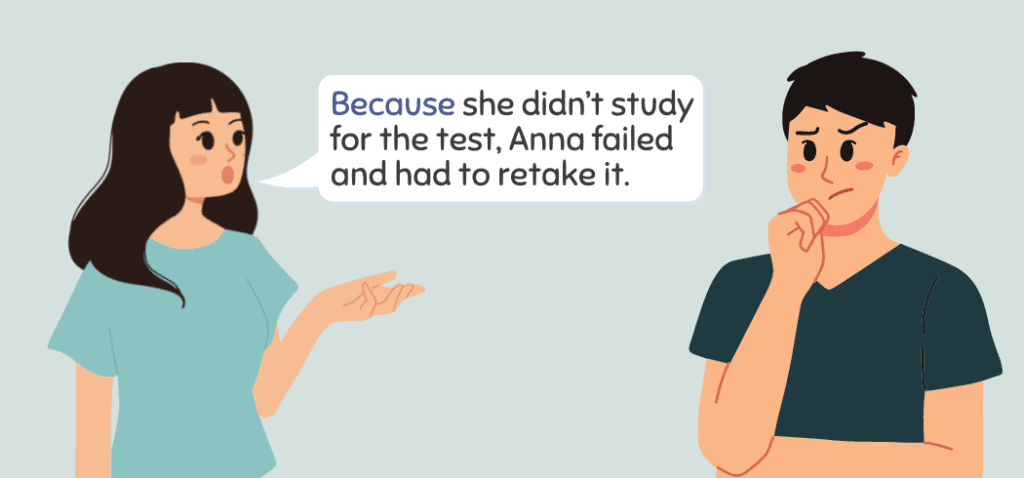
You might also spot transitional devices for essays that show consequences, results, and effects.
- As a result
- In that case
- Under those circumstances
- Accordingly
- Consequently
Consider the examples below.
- We watered the plant for seven days. In effect, it grew three inches taller.
- Because she didn’t study for the test, Anna failed and had to retake it.
Conclusion/Summary/Restatement
These words and phrases show transitions between sentences to show conclusions. You’ll find these words in essay conclusions of different essay types.
- In simple language
- In explanation
- In lay terms
- In a nutshell
- As can be seen
- In simple terms
- Generally speaking
- All things considered
- As shown above
- In the final analysis
- In the long run
- In either case
- Given these points
- As has been noted
- In any event
- On the whole
- By and large
- For the most part
- In conclusion
- To summarize
Note that in lay terms and in explanation are formal alternative choices to “ in a nutshell.”
Here are some examples.
- Matter is a material that occupies space and has mass. In simple language, it is any physical substance.
- I don’t want to climb the corporate ladder. After all, money isn’t everything.
Time/Chronology/Sequence
Linking words’ other role in writing is to show sequence or chronology. Under the time category, these phrases add a meaning of time. You can find these words in an essay introduction when the writer explains how the paper is structured.
- In due time
- From time to time
- At the present time
- Sooner or later
- Up to the present time
- To begin with
- Straightaway
- In the meantime
- In a moment
- Without delay
- All of a sudden
- At this instant
- First, second
- By the time
- Immediately
- Occasionally
- I watched the movie on television. Eventually, I fell asleep.
- First, fill the pan with water. Then, bring it to a boil.
Space/Location/Place
The following transition words are famous adverbial expressions that limit or modify space. Some of these words and phrases are also transition words of time.
- In the middle of
- To the left/right
- In front of
- On this side
- In the distance
- In the foreground
- In the background
- In the center of
- Adjacent to
- Opposite to
Below are sentence examples using transition words of space.
- My house is located behind the building.
- To the left of the supermarket is a flower shop.
Common Mistakes With Transition Words
Transition words help you create a flow of arguments for readers to understand what you’re saying. But misused transition words and phrases will make your writing unclear. Avoid these mistakes to give your readers a better experience.
Starting a Sentence With So, And, and Also
Both so and and are coordinating conjunctions, which means they can start independent clauses that stand on their own. But it’s not recommended to use these words and also as sentence starters in formal writing. For example:
- Incorrect: Also, there are unauthorized charges on my credit card account.
- Correct: Furthermore, there are unauthorized charges on my credit card account.
Combination of Transition Words And/Or
When writing an essay, avoid English transition words and/or because it makes your paper look messy. Instead, consider whether you need both connectors or only one of them. If you need them both, try this alternative.
- Incorrect: boat and/or plane.
- Correct: boat, plane, or both.
Using As Well As as Alternative to And
As well as has a different meaning from the transition word and. And means you’re listing something of equal importance. Meanwhile, as well as is for additional, less essential information. Here’s an example.
- Incorrect: In this paper, I discuss my movie analysis as well as provide recommendations for improvement.
- Correct: In this paper, I discuss my movie analysis and provide recommendations for improvement.
Archaic Words
Your writing may not make any sense to readers if you overuse archaic transition words like therewith .
For example, hereby means as a result. We can replace it with more modern and explicit phrasing expressing how the current statement is connected to the previous statement.
Linking Words Summary
A linking word is a term that connects different ideas in your text, whether they are contrasting, supporting, or adding. They can improve your writing and help it flow better, I promise!
Regardless of the style of writing, every piece of writing contains linking words to show perfect transitions. I hope my guide on the definition and list of transitions helps you use these words and phrases correctly. Memorize each category, and don’t overuse them in essays.
Grammarist is a participant in the Amazon Services LLC Associates Program, an affiliate advertising program designed to provide a means for sites to earn advertising fees by advertising and linking to Amazon.com. When you buy via the links on our site, we may earn an affiliate commission at no cost to you.
2024 © Grammarist, a Found First Marketing company. All rights reserved.
75 linking words for academic writing (+examples)
Linking words play an important role in academic writing: They connect different paragraphs, sections or ideas in a text. Therefore, they considerably improve the readability and argumentation of academic texts such as a thesis, dissertation, essay or journal publication. This list of 75 linking words includes examples of how they can be used in academic writing.
Disclosure: This post may contain affiliate links, which means I may earn a small commission if you make a purchase using the links below at no additional cost to you . I only recommend products or services that I truly believe can benefit my audience. As always, my opinions are my own.
Linking words expressing order and sequence in academic writing
Linking words expressing additions in academic writing, linking words expressing cause and effect in academic writing, linking words expressing contrasts and comparisons in academic writing, linking words expressing emphasis in academic writing, linking words expressing illustrations in academic writing, linking words expressing summaries and conclusions in academic writing, linking words expressing conditionality in academic writing, linking words expressing generalisations in academic writing, linking words expressing concessions in academic writing.
1. First(ly), second(ly), third(ly)
Example: First, I review the existing literature on cross-border collaboration. Second, I explain the methodology …
Example: The thesis starts with a literature review. Next, I describe the case study design.
Example: Finally, recommendations for future research are presented.
4. Subsequently
Example: Study participants underwent several experiments and were subsequently examined.
5. Afterwards
Example: The event increased public awareness of this issue. Afterwards, politicians debated it more openly.
6. Eventually
Example: Eventually, this led to the creation of a social movement.
Example: Before scientists discovered the role of neurons in information processing, they assumed that…
8. Previously
Example: Previously, scholars believed that nurture was the most important factor in a child’s development.

Example: Scholars examine the causes and effects of poverty.
10. Furthermore
Example: Furthermore, the data illustrates the number of chemicals that can be found in drinking water.
11. Additionally
Example: Additionally, the interviewee lamented a lack of attention to his work.
12. As well as
Example: Scholars utilise qualitative as well as quantitative methods to study this phenomenon.
13. Besides
Example: Besides the public outreach component, we wrote a handbook to disseminate the research results in the academic community.
Example: The financial compensation was also appreciated by the study participants.
15. Moreover
Example: Moreover, interviewees were asked to describe their own experiences.
You may also like: How to paraphrase a quote: 4 simple strategies
16. Because
Example: This theory was ultimately rejected because it was built on a flawed dataset.
Example: The outcomes improved since different parties joined forces.
Example: As the number of studies increases, better conclusions can be drawn.
Example: Scientists realised that the data analysis had flaws. So they decided not to run the same data analysis again.
20. Therefore
Example: Many researchers have conducted this experiment with similar results. Therefore, this theory can be debunked.
21. Consequently
Example: The literature highlights the importance of age and physical fitness. Consequently, these factors will be investigated further.
Example: Due to a low response rate, the study’s validity is low.
23. Nevertheless
Example: One academic study found the opposite results. Nevertheless, it can be argued that…
Example: Many scholars have explored this issue. Yet, to date, no inclusive framework exists to explain…
25. Although
Example: Although a confidentiality agreement was provided, study participants were hesitant to disclose private information.
26. In spite of
Example: In spite of the different study contexts, all experiments pointed to similar results.
27. Whereas
Example: People often stated that they are aware of the rules whereas they behaved as if they did not.
Example: While older studies often emphasise structural effects, newer ones tend to highlight the role of agency.
29. In contrast
Example: In contrast to previous findings, my analysis shows that…
30. Similarly
Example: One study found that the majority of residents in disadvantaged areas do not have access to sufficient resources. Similarly, my research revealed that most residents live too far away from the services and resources they would need to climb the social ladder.
31. Equally
Example: E qually important, however, is the role of personal beliefs in decision-making processes.
32. Likewise
Example: The interviewee considered this issue important and expected his colleagues to do likewise.
33. On the other hand
Example: On the one hand, research in this field advanced considerably in the last 20 years. On the other hand, a lot remains unclear.
Example: Unlike social scientists, physical scientists often conduct laboratory examinations.

If you are looking to elevate your writing and editing skills, I highly recommend enrolling in the course “ Good with Words: Writing and Editing Specialization “, which is a 4 course series offered by the University of Michigan. This comprehensive program is conveniently available as an online course on Coursera, allowing you to learn at your own pace. Plus, upon successful completion, you’ll have the opportunity to earn a valuable certificate to showcase your newfound expertise!
35. Particularly
Example: Particularly relevant for this study is the molecular orbital theory.
36. Especially
Example: Especially younger interviewees expressed dissatisfaction with the status quo.
37. Above all
Example: Above all, this method can generate better insights into the physical processes at hand.
Example: Indeed, motivation turned out to be a defining factor of academic success.
38. Clearly
Example: Clearly, these scholars were not aware of recent advances in medical sciences.
39. Definitely
Example: This was definitely the most important event of the year.
40. Importantly
Example: More importantly, the findings underscore the importance of conflict resolution.
41. Undoubtedly
Example: Undoubtedly, all stakeholders had good intentions.
42. Obviously
Example: Obviously it is too early to draw final conclusions.
43. Of course
Example: Of course, this study should be replicated in a different context.
44. Surprisingly
Example: Surprisingly, all results were unambiguous.
45. Such as
Example: Scientists have explored different parts of the problem, such as CO2 emissions and hydrological processes.
46. For example
Example: Many interviewees were nervous. For example, when asked to describe the event, some of them started to stutter.
47. For instance
Example: Scholars have criticised this approach for different reasons. For instance, they argued that qualitative methods are insufficient to draw generalisable conclusions.
48. In this case
Example: Difficulties arise when no study participants can be found. In this case, alternative methods should be considered.
50. To conclude
Example: To conclude, the empirical analysis supports previous research findings.
51. In conclusion
Example: In conclusion, the reviewed literature highlights a clear research gap.
52. To sum up
Example: To sum up, a mixed methods approach is a better choice than a purely quantitative one.
53. In summary
Example: In summary, it is my opinion that conditions should be improved.
54. In short
Example: In short, scholars call for more research on climate change mitigation.
55. Altogether
Example: Altogether, these examples support the main argument.
Example: Energy supply became a growing problem. Thus, new policies were implemented.
Example: The first dataset was incomplete. Hence, a new dataset had to be developed.
Example: Unless stated otherwise, I refer to the concept as…
59. As long as
Example: As long as the conditions do not change, the results should remain stable.
Example: If scientists study this phenomenon in the future, they should pay attention to structural drivers.
61. Provided that
Example: Provided that nothing changes, the effects on society will be negative.
Example: Should the distribution change, it is fair to expect…
63. Even if
Example: Even if more experiments are conducted, human behaviour remains hard to predict.
Example: Often, this issue was flagged by interviewees themselves.
65. Commonly
Example: Commonly, this criterion is used for categorising plants.
66. Overall
Example: Overall the data confirmed the hypothesis.
67. Typically
Example: Typically emotions run high in such situations.
68. Generally
Example: Generally speaking, scholars address this issue from two angles.
Example: Mainly researchers in the global North discuss this phenomenon.
Example: Mostly, these results cannot be replicated outside of the lab.
71. Even if
Example: This is hard to prove. Even if the study sample is large enough.
72. Regardless of
Example: Regardless of their genetic makeup, mice showcased the same symptoms.
Example: Albeit experiencing setbacks, successful students do not get discouraged.
74. Admittedly
Example: Admittedly, the validity of this study should be increased.
75. Nonetheless
Example: Nonetheless, this study can be seen as a valuable contribution to the international literature.
Master Academia
Get new content delivered directly to your inbox.
Subscribe and receive Master Academia's quarterly newsletter.
How to paraphrase a quote: 4 simple strategies
The best coursera courses for phd researchers in 2023, related articles.

Juggling research and teaching obligations

17 strong academic phrases to write your literature review (+ real examples)

10 tips on how to use reference management software smartly and efficiently

Introduce yourself in a PhD interview (4 simple steps + examples)
Transitional Words and Phrases
One of your primary goals as a writer is to present ideas in a clear and understandable way. To help readers move through your complex ideas, you want to be intentional about how you structure your paper as a whole as well as how you form the individual paragraphs that comprise it. In order to think through the challenges of presenting your ideas articulately, logically, and in ways that seem natural to your readers, check out some of these resources: Developing a Thesis Statement , Paragraphing , and Developing Strategic Transitions: Writing that Establishes Relationships and Connections Between Ideas.
While clear writing is mostly achieved through the deliberate sequencing of your ideas across your entire paper, you can guide readers through the connections you’re making by using transitional words in individual sentences. Transitional words and phrases can create powerful links between your ideas and can help your reader understand your paper’s logic.
In what follows, we’ve included a list of frequently used transitional words and phrases that can help you establish how your various ideas relate to each other. We’ve divided these words and phrases into categories based on the common kinds of relationships writers establish between ideas.
Two recommendations: Use these transitions strategically by making sure that the word or phrase you’re choosing matches the logic of the relationship you’re emphasizing or the connection you’re making. All of these words and phrases have different meanings, nuances, and connotations, so before using a particular transitional word in your paper, be sure you understand its meaning and usage completely, and be sure that it’s the right match for your paper’s logic. Use these transitional words and phrases sparingly because if you use too many of them, your readers might feel like you are overexplaining connections that are already clear.
Categories of Transition Words and Phrases
Causation Chronology Combinations Contrast Example
Importance Location Similarity Clarification Concession
Conclusion Intensification Purpose Summary
Transitions to help establish some of the most common kinds of relationships
Causation– Connecting instigator(s) to consequence(s).
accordingly as a result and so because
consequently for that reason hence on account of
since therefore thus
Chronology– Connecting what issues in regard to when they occur.
after afterwards always at length during earlier following immediately in the meantime
later never next now once simultaneously so far sometimes
soon subsequently then this time until now when whenever while
Combinations Lists– Connecting numerous events. Part/Whole– Connecting numerous elements that make up something bigger.
additionally again also and, or, not as a result besides even more
finally first, firstly further furthermore in addition in the first place in the second place
last, lastly moreover next second, secondly, etc. too
Contrast– Connecting two things by focusing on their differences.
after all although and yet at the same time but
despite however in contrast nevertheless nonetheless notwithstanding
on the contrary on the other hand otherwise though yet
Example– Connecting a general idea to a particular instance of this idea.
as an illustration e.g., (from a Latin abbreviation for “for example”)
for example for instance specifically that is
to demonstrate to illustrate
Importance– Connecting what is critical to what is more inconsequential.
chiefly critically
foundationally most importantly
of less importance primarily
Location– Connecting elements according to where they are placed in relationship to each other.
above adjacent to below beyond
centrally here nearby neighboring on
opposite to peripherally there wherever
Similarity– Connecting to things by suggesting that they are in some way alike.
by the same token in like manner
in similar fashion here in the same way
likewise wherever
Other kinds of transitional words and phrases Clarification
i.e., (from a Latin abbreviation for “that is”) in other words
that is that is to say to clarify to explain
to put it another way to rephrase it
granted it is true
naturally of course
finally lastly
in conclusion in the end
to conclude
Intensification
in fact indeed no
of course surely to repeat
undoubtedly without doubt yes
for this purpose in order that
so that to that end
to this end
in brief in sum
in summary in short
to sum up to summarize

Improving Your Writing Style
This is an accordion element with a series of buttons that open and close related content panels.
Clear, Concise Sentences
Use the active voice
Put the action in the verb
Tidy up wordy phrases
Reduce wordy verbs
Reduce prepositional phrases
Reduce expletive constructions
Avoid using vague nouns
Avoid unneccessarily inflated words
Avoid noun strings
Connecting Ideas Through Transitions
Using Transitional Words and Phrases

IMAGES
VIDEO
COMMENTS
How to improve your essay using connective words and phrases: with defintions, examples and lists of the top connectives for essays!
50 linking words to use in academic writing. academic writing. linkers. essay writing. thesis. ESL. English. It’s very common for students to use long words they don’t understand very well in their essays and theses because they have a certain idea of what academic writing should be.
Linking / transition words and phrases join ideas, sentences and paragraphs together. They should be used within sentences and to move from one idea to another (between sentences). These words and phrases indicate the direction, order and flow of ideas.
Struggling to connect sentences smoothly in your essays or speaking? This list of linking and transition words explains the uses and definitions of key words like “however” with examples, perfect for IELTS and more.
Moreover, you can use essay transition words to start a paragraph, sentence, or clause more naturally. Additionally, essay transition words can connect new information to the previous statement so you don’t have to say everything at once. This guide looks at how to use transition words in essays.
Linking words play an important role in academic writing: They connect different paragraphs, sections or ideas in a text. Therefore, they considerably improve the readability and argumentation of academic texts such as a thesis, dissertation, essay or journal publication.
Academic writing usually deals with complex ideas. To enable the reader to follow your thoughts, they need to be clearly and smoothly linked. To join ideas and sentences, we use a number of connecting words and phrases.
Two recommendations: Use these transitions strategically by making sure that the word or phrase you’re choosing matches the logic of the relationship you’re emphasizing or the connection you’re making.
Transition words and phrases (also called linking words, connecting words, or transitional words) are used to link together different ideas in your text. They help the reader to follow your arguments by expressing the relationships between different sentences or parts of a sentence.
There are four main categories of connective devices used extensively in academic writing: • Adding information: and, furthermore, in addition, also. • Chronology: previously, subsequently, firstly. • Cause and effect: if, therefore, thus, consequently. • Compare and contrast: similarly, in contrast, however. Learning Experience Team.